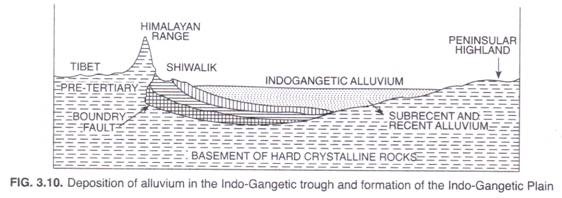Here is your paragraph on the Origin of Indo-Gangetic Plain !
It is almost universally accepted that this vast plain has been formed as a result of filling of a deep depression lying between the Peninsular and the Himalayan region by the depositional work of the rivers coming from these two landmasses.
However, divergent views have been expressed regarding the origin of this great depression and the process of filling it. Wadia postulates that these planes were originally a deep depression or furrow lying between the Peninsula and the mountain region.
The great Austrian geologist Edward Suess has suggested that a “foredeep” was formed in front of high crust- waves of the Himalayas as they were checked in their southward advance by inflexible solid landmass of the Peninsula.
This foredeep was like a large syncline in which alluvium brought by the Himalayan and the Peninsular rivers was deposited. In due course of time, this was filled with alluvium and the Great Plain of North India was formed. It rests on the hard and crystalline rocks through which the region is connected to the Himalayan and the Peninsular blocks (Fig. 3.10).
Sir Sydney Burrard, on the other hand, thinks that the Indo-Gangetic alluvium conceals a great deep rift, or fracture, in the earth’s sub-crust, several thousand metres deep, the hollow being subsequently filled up by detrital. He ascribes to such sub-crustal cracks or rifts a fundamental importance in geotectonics and attributes the elevation of the Himalayan chain to an incidental bending or curbing movement of the northern wall to the fissure.
ADVERTISEMENTS:
Such sunken tracts between parallel, vertical dislocations are called ‘Rift Valleys’. The rift valley between the Himalayan ranges and the Peninsula which gave birth to this plain was about 2,400 km long and hundreds of metres deep. His findings were based on some anomalies in the observations of the deflections of the plumb line and other geodetic considerations. He described some other rift valleys of the Himalayan region as well as the rift valleys of Narmada and Tapi in the Peninsular India.
Scholars like Hayden and R.D. Oldham as well as other geologists of the Geological Survey of India have not accepted Burrard’s view of the Indo-Gangetic depression. The main objection to Burrard’s views is that there is no trace of a rift valley at the northern edge of the Peninsula and that such a vast rift valley is not possible.
According to the recent views expressed by many geologists and geographers, sediment deposited at the bed of the Tethys Sea was folded and warped due to northward drift of the Peninsula. Consequently the Himalayas and a trough to the south were formed.
The origin of this depression or trough, lying at the foot of the mountain, is doubtless intimately connected with the latter. The Great plain represents the infilling of the foredeep warped down between the advancing Peninsular Block and the Himalayas.
The infilling has been done by the deposition of the detritus of the mountain brought by the numerous rivers emerging from them during the period of great gradational activity. Geologically most parts of this plain are of the Pleistocene and Recent formations. Thus, the surface deposits of this tract belong to the last chapter of the earth’s history and conceal beneath them the older peninsular and other formations.
